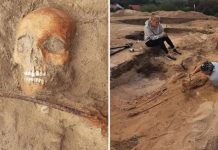A 3400-year-old city from the Mittani Empire that was formerly situated on the Tigris River has been discovered by a group of German and Kurdish archaeologists.
Early this year, as a result of the severe drought in Iraq, a town erupted from the waters of the Mosul reservoir.
Ancient Zakhiku, which is thought to have been a significant center in the Mittani Empire, may have been the sprawling city with the palace and other major buildings (ca. 1550-1350 BC).
Iraq is one of the nations most impacted by climate change worldwide.

Particularly the south of the nation has endured months of severe drought.
Large volumes of water have been removed from Iraq’s most significant water storage, the Mosul reservoir, in order to keep crops from drying up.
Without any preceding archaeological research, this caused a Bronze Age city that had been drowned decades earlier to resurface.
It is situated in the Iraqi Kurdistan Region in Kemune.
Archaeologists were suddenly under pressure to unearth and document at least some of this vast, important metropolis as soon as possible before it was resubmerged due to this unforeseen event.

Within days, a team for the rescue excavations had been assembled.
The Fritz Thyssen Foundation provided funding for the project on short notice through the University of Freiburg.
There was a great deal of urgency on the part of the German-Kurdish archaeological team because it was unclear when the reservoir’s water level would rise again.
The researchers quickly completed a substantial portion of the city’s mapping.
A gigantic fortification with wall and towers, a monumental, multi-story storage building, and an industrial complex were discovered in addition to a palace, which had already been identified during a brief campaign in 2018.

The vast urban complex was built during the Mittani Empire (1550–1350 BC), which ruled over a sizable portion of northern Mesopotamia and Syria.
The finding of five ceramic receptacles that held a collection of more than 100 cuneiform tablets is particularly noteworthy.
They were created during the Middle Assyrian era, not long after the disastrous earthquake that ravaged the city.
Even some of the clay tablets’ clay envelopes, which may be letters, are still there.
The finding could reveal crucial details about when the Mittani-period metropolis came to an end and Assyrian hegemony over the area began.
According to Peter Pfälzner, “It is almost miraculous that cuneiform tablets made of unfired clay survived for so long beneath water.”
As part of a comprehensive conservation project supported by the Gerda Henkel Foundation, the excavated buildings were totally covered with tight-fitting plastic sheeting and topped with gravel fill to prevent additional harm to the significant site from the rising water.
This is done to prevent water from damaging the unbaked clay walls and any other treasures that may still be buried inside the ruins.
Now the area is entirely underwater once more.









